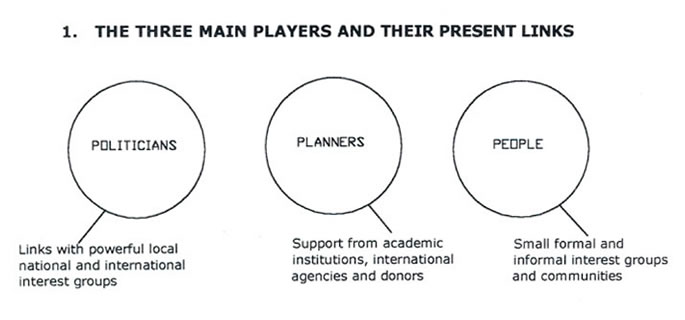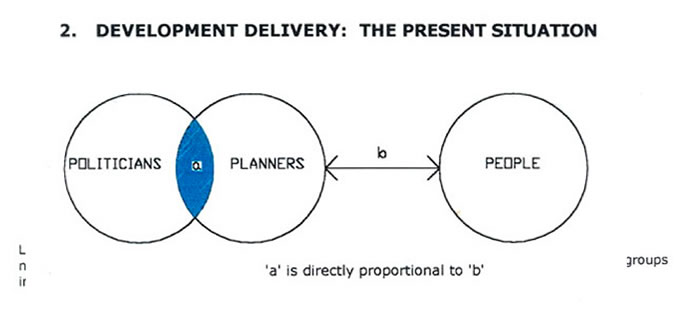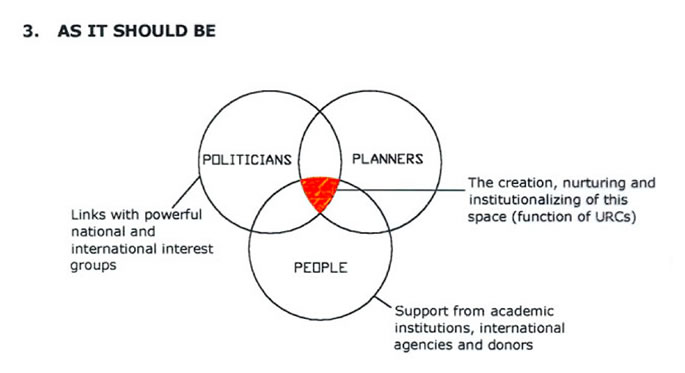The Rationale behind the Urban Resource Centre Concept
1. Preamble
1.1 A lot of information regarding urban conditions and processes is developed by NGOs, CBOs, professional institutions and academia. This information is scattered; it is very different in nature from official information; it does not get publicised and nor is it easily available; and it does not feed into the official planning process or for awareness-raising.
1.2 The print media carries a lot of reports on various subjects related to urban issues and official plans from different points of view. Since these reports are spread over years and are on different topics they cannot be related subject-wise or time-wise with each other. Thus, by reading the press a larger picture regarding issues and plans does not emerge.
1.3 Government plans are made by a powerful nexus between politicians, bureaucrats, formal sector developers and international agencies and their consultants. Development is viewed entirely from the point of view of this nexus and the people and informal interest lobbies, who are more often than not the victims of these plans, are never consulted about them. Thus corruption, in the absence of transparency, is an essential part of the planning process.
1.4 CBOs, informal interest groups (also weaker formal ones) and communities who are often the victims of formal sector planning, constantly petition, demonstrate, and seek legal redress against insensitive projects. They are usually told that there is no option to the proposed plans and that these plans are in the larger interests of the city. The CBOs, weaker interest groups and communities get to know of them to these plans only after physical work begins on them and even if they get to know of them earlier, they do not have the expertise to analyse them, present their concerns in the right vocabulary or to present viable alternatives. Thus, the lobbying process becomes an exercise in “requesting” or in “demanding” through political agitation. Both seldom succeed because the “requests” and “demands” do not relate to larger planning issues.
1.5 It has been noticed that where planning is the result of consultation between various interest groups who also supervise its implementation, plans are more sensitive, appropriate and in keeping with ground realities. Again, where community or interest groups requests and or protests are backed by professional advice, alternatives and costs, they are taken seriously and their recommendations are more early accommodated.
2. What is Required
2.1 Keeping the above in view, what is required is the gathering and cataloguing of all scattered information so that it is available to journalists, interest groups, communities and NGOs/CBOs.
2.2 What is also required is the collection of all government plans and their analysis on how they will affect the city and the communities they are impacting on. The results of this analysis should be taken to the communities, government officials, interest groups and to the press.
2.3 All newspaper information should be catalogued subject-wise over time and analysed. This knowledge should be shared with interest groups, the press and the public at large.
2.4 Alternatives to government plans, along with costs, should be developed and made public.
2.5 A space should be created for interaction between all relevant groups, people and government agencies. Also support organisations in different disciplines must be identified to help communities in preparing their requests and or protests.
3. A Urban Resource Centre (URC) Can do All This
3.1 A URC can undertake all that is mentioned in paragraph 2 and it can lead to the creation of a movement for more appropriate-people-friendly-planning of which transparency and accountability is an integral part.
3.2 Karachi’s URC consist of a 3 member staff. An architect, a social organiser and an administrator. The URC is supported by voluntary professionals as and when required.
3.3 Considerable strength is provided to the URC because of its association with the Department of Architecture and Planning at the Dawood College (whose students’ studio work is often on subjects of relevance to the URC) and the Orangi Pilot Project (who has strong links with residents of over 100 informal settlements in Karachi and knows how to mobilise people).
3.4 The Karachi URC:
- Keeps subject-wise news clippings (so that each subject reads like a story) and publishes a monthly “Facts and Figures” sheet derived from these clippings.
- It carries out an analysis of all major urban projects and analyses them with the help of stakeholders. Then it presents them to a forum of interest groups and relevant government agencies.
- It carries out research on topics that emerge from the press clippings from a people’s point of view and gets them published (or tries to) in the press.
- It holds forums on different issues of relevance to poor communities where communities can interact with each other and form links with each other. It puts communities in touch with NGOs or resource persons who can be a help to them professionally. All forums are documented and a synopsis is made available to the press.
- The URC, based on its work, also proposes changes in laws, rules and regulations for Karachi’s planning and conservation issues and presents them to its forums.
3.5 The URC concept is expressed figuratively below:
a) Three groups in the planning process:

b) Present planning process:

c) The aim of the URC:

